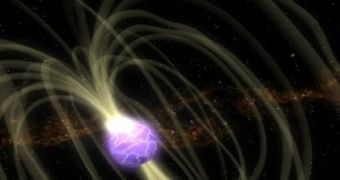Soft gamma repeaters are among the rarest objects in the Universe, and only a handful have thus far been identified. In August, 2008, the American space agency's Swift satellite discovered multiple blasts of radiation coming in from such an SGR, but it did not analyze the phenomenon thoroughly. Recently, the European Space Agency (ESA), making use of its XMM-Newton and International Gamma-Ray Astrophysics Laboratory (INTEGRAL) satellites, has managed to determine that the radiations are actually caused by an equally rare celestial object, namely a magnetar.
Magnetars are specific types of neutron stars, which are usually formed when massive stars collapse onto themselves. This class of celestial bodies is the most highly magnetized in the universe, and theorists hypothesize that there couldn't possibly exist anything that exerts more gravitational pull to its core than a magnetar. According to University of Amsterdam Astronomer Nanda Rea, the leader of the new research, object SGR 0501+4516 is only the fifth SGR ever discovered, and the first one over the last ten years.
“Some sources are extremely active, but others can be quiet for a decade or more. This suggests many members of this class remain unknown,” the scientist adds. And that is a loss to science and astronomy, some researchers say, because magnetars, with their magnetic fields roughly 100 trillion times stronger than that exerted by our planet, can offer unique insight into how exceptional magnetic conditions can influence both visible matter and dark matter.
“Magnetars allow us to study extreme matter conditions that cannot be reproduced on Earth,” University of California in Berkeley (UCB) Astronomer Kevin Hurley, also a member of the team that has made the latest observations, explains. He also highlights the fact that, all things considered, experts only know of about 15 objects that can be classified as magnetars, including both SGR sources and anomalous X-ray pulsars, a different type of high-energy neutron stars, which produces unbelievable amounts of gamma-ray and X-ray radiation.

 14 DAY TRIAL //
14 DAY TRIAL //